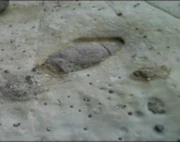
Emory University paleontologist Anthony Martin found evidence of dinosaur burrows in Victoria, Australia.
- "Three enigmatic structures in an outcrop of the Otway Group (Albian) of Victoria, Australia, compose the first known evidence suggestive of dinosaur burrows outside of North America and the oldest from the fossil record. The most complete of the Otway structures nearly matches the size and morphology of a burrow attributed to the only known burrowing dinosaur, Oryctodromeus cubicularis from the Upper Cretaceous (Cenomanian) of Montana (USA). The suspected burrows cross-cut alluvial facies and overlie nearby strata containing dinosaur tracks. The structures contain identical sand fills in their upper portions, implying a near-synchronous origin and filling; graded bedding in the most complete structure also indicates passive filling of an originally open structure. This probable burrow is a 2.1 m long, gently descending, semi-helical tunnel, with a near-constant diameter (about 30 cm) that connects with an enlarged terminal chamber. The structures are unlikely to have been caused by physical or chemical sedimentary processes, and hence are considered as biogenic structures; moreover, their size and morphology imply tetrapod tracemakers. Burrow allometry indicates tracemakers with a mass of 10-20 kg, matching size estimates for small ornithopods from the Otway Group. Burrowing behavior in hypsilophodontid-grade dinosaurs, which compose most of the dinosaurian assemblage in the Lower Cretaceous of Victoria, was proposed previously as an adaptation for surviving formerly polar conditions in southeastern Australia. This paradigm is explored in detail, particularly through actualistic examples of tetrapod burrowing in cold climates. These structures may provide the first clues of ornithopod burrowing in these extreme environments, while also establishing search images for similar structures in other Lower Cretaceous outcrops in Victoria."
- ―Abstract of 2009 dinosaur burrows discovery[src]
In 2009, a journal article in Cretaceous Research highlighted the recent find of dinosaur burrows in Victoria, Australia. The research paper indicates that various dinosaur species exhibited digging and burrowing behavior.[1][2]
In 2006, Anthony Martin, along with colleagues from Montana State University and Japan, described the 95-million-year-old dinosaur species Oryctodromeus cubicularis (meaning "digging runner of the lair"). The genus is based on a small adult dinosaur and two juveniles in a fossilized burrow in southwestern Montana.[1]
The researchers hypothesized that dinosaurs may have utilized burrows for caring for their young, as well as allowing them to survive extreme temperatures and harsh environments.[1] During a hike to a remote site known as Knowledge Creek, west of Melbourne, Anthony Martin uncovered the trace fossil of what appeared to be a burrow almost identical to the one he had identified in Montana.[1] The burrow was from an Early Cretaceous (Albian) outcrop, and is about six-feet long and one-foot in diameter, and is in the shape of a semi-spiral, ending in an enlarged chamber. Martin later found two similar trace fossils in the same area.[1][2] Martin described the trace fossil as being made by small ornithopod dinosaurs.[2]
The trace fossils dare to around 100 million years ago, roughly the same time that the Australia continent split withh Antarctica. During the polar winters at that time, temperatures would easily have been near or below freezing. Previously, researchers had theorized that the small dinosaurs in this region had survived the harsh weather by sheltering beneath vegetation. This recent find, however, indicates that small dinosaurs may have burrowed into the soft mud banks near rivers.[1][2]
The age, size and shape of the likely burrows led Martin to hypothesize that they – herbivores that were prevalent in the region. These ornithopods stood upright on their hind legs and were about the size of a large, modern-day iguana.
"It's fascinating to find evidence connecting a type of behavior between dinosaurs that are probably unrelated, and lived in different hemispheres during different times," Martin says. "It fills in another gap in our understanding of the evolution of dinosaurs, and ways they may have survived extreme environments."